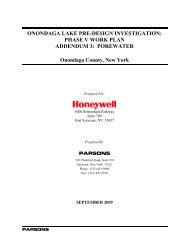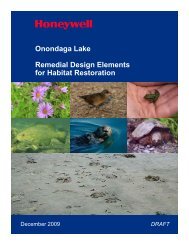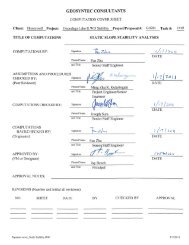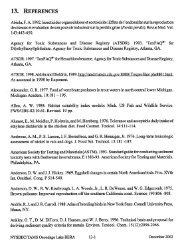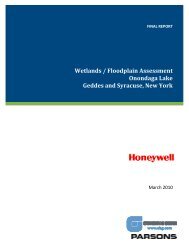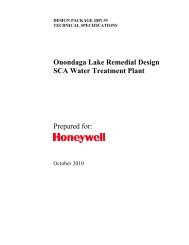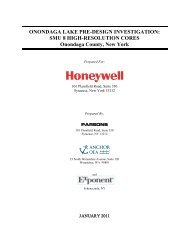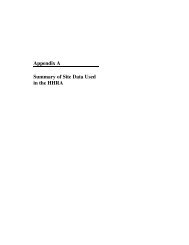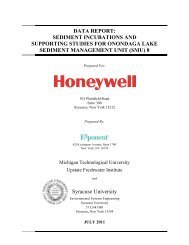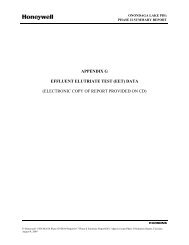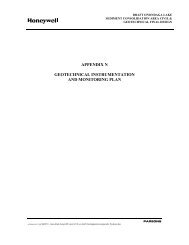Phase 1B Underwater Archaeological Report for the Onondaga ...
Phase 1B Underwater Archaeological Report for the Onondaga ...
Phase 1B Underwater Archaeological Report for the Onondaga ...
Create successful ePaper yourself
Turn your PDF publications into a flip-book with our unique Google optimized e-Paper software.
FINAL<br />
<strong>Phase</strong> IB <strong>Underwater</strong> <strong>Archaeological</strong> Resources <strong>Report</strong> <strong>for</strong> <strong>Onondaga</strong> Lake Superfund Site<br />
which might suggest an underlying wreck or that <strong>the</strong> mound is some type of pier, but nothing of that nature was apparent<br />
anywhere. The magnetic signature was certainly <strong>the</strong> result of <strong>the</strong> ferrous debris mixed in <strong>the</strong> mound. The pieces of iron<br />
debris found with <strong>the</strong> detector were within <strong>the</strong> mound and partially buried, indicating <strong>the</strong>ir deposition was<br />
contemporaneous with <strong>the</strong> stone pile <strong>for</strong>mation.<br />
GPS locations <strong>for</strong> A34:<br />
A34-A 928190.48 1118625.36<br />
A34-B 928228.86 1118605.64<br />
A34-C 928202.01 1118607.95<br />
A34-D 928212.10 1118628.93<br />
The dimensions of <strong>the</strong> rock pile are 42½‘ x 23½‘.<br />
1416 AK out of <strong>the</strong> water.<br />
1430 Head back to marina to pick up 6 volt batteries <strong>for</strong> <strong>the</strong> comms unit.<br />
1530 Depart Liverpool Marina <strong>for</strong> A6.<br />
A6 1606 ST into <strong>the</strong> water to verify A6. After a few minutes of searching, ST returns to <strong>the</strong> boat <strong>for</strong> metal detector. Patches of<br />
aquatic vegetation with open areas of solvay waste. Some weed very high; o<strong>the</strong>rs relatively low. No cultural objects seen.<br />
CW looked at sonar data and believes that <strong>the</strong> original acoustic anomaly was a solvay waste shelf.<br />
1649 ST out of <strong>the</strong> water.<br />
1710 Depart worksite <strong>for</strong> marina.<br />
1720 Arrive marina. Break down gear.<br />
1750 Depart Marina. End of day.<br />
June 22, 2011<br />
0600 Meet with ST & PAL <strong>for</strong> breakfast. Wea<strong>the</strong>r looks bad with scattered T-storms all day. Kelly Miller calls. We discuss wea<strong>the</strong>r<br />
outlook and call it a wea<strong>the</strong>r day.<br />
0700 AK, ST & PAL meet to discuss survey methodology <strong>for</strong> Syracuse Maritime Historic District (SMHD).<br />
0830 Depart hotel <strong>for</strong> marina. Inventory necessary gear <strong>for</strong> SMHD survey.<br />
1000 Depart marina <strong>for</strong> supply shopping. West Marine and Home Depot <strong>for</strong> survey supplies.<br />
1200 Lunch.<br />
1300 Back at marina. Set up four reels, each with 1000’ of poly line. The survey strategy <strong>for</strong> <strong>the</strong> Syracuse Maritime Historic<br />
District is to set up transects at set intervals using <strong>the</strong> reel and travel lines with mushroom anchors at ei<strong>the</strong>r end to hold <strong>the</strong><br />
line in place on <strong>the</strong> bottom. The survey transect will be placed in a pre-determined location by putting drop weights<br />
without markers at ei<strong>the</strong>r end of <strong>the</strong> transects. [drawing of transects]<br />
Transects are 1000’ long, running perpendicular to <strong>the</strong> shoreline.<br />
1500 Arrive back at hotel. End of day.<br />
June 23, 2011<br />
207



